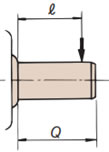Technical Data Reducers Miter and Bevel Gear Boxes Selection
To view selection procedures and precautions, please proceed to the following.
Click here to narrow down the product series or to make a tentative selection.
If you have specific conditions of use and wish to make a detailed selection, please click here.
Miter Gear Box Selection
Required conditions
1. Machine, system, and layout
2. Operating conditions
- ・Motor type
- ・Load torque [N・m] or transmission [kW]
- ・Operating hours : ( ) hours/day Continuous/Intermittent
- ・Start/Stop frequency : ( ) times/hour
- ・Input rotation speed : Constant ( ) rpm, Max. ( ) rpm
- ・Input shaft direction : Lateral shaft, Cross shaft
- ・Reduction ratio : 1:1, 1.5:1, 2:1, 2.5:1, 3:1
- ・Load types : Uniform load, Load with moderate impact, or Load with large impact
3. Operating environments
- ・Operating environment : Indoors, Outdoors, Near furnaces, Inside freezers, or Other ( )
- ・Ambient temperature : Constant ( ) °C, High temperature ( ) °C, or Low temperature ( ) °C
- ・Ambient atmosphere : Salt, Dust and particles, Acid, or Other ( )
4. others
- ・Refer to the product page for options and special types.
Please also use the Inquiry Form for Selection.
Selection procedure
Consider the selection requirements and select a model according to the following steps:
1. Determine the service factor
The transmission capacity values in the catalogs are all based on a service factor of 1.0.
Find the service factor from the service factor table (Table 1) according to operating conditions.
2.Calculate the corrected torque or corrected kW
Calculate the corrected torque or corrected kW using the service factor.
Corrected torque or corrected kW = (Load torque or transmission kW applied to the Miter Gear Box) × Service factor (Table 1)
Table 1 Service factor
| Load characteristics | Operating hours | ||
|---|---|---|---|
| 2 hours | 10 hours | 24 hours | |
| Constant load | 1.00 (1.00) |
1.00 (1.25) |
1.25 (1.50) |
| Load with light impact | 1.00 (1.25) |
1.25 (1.50) |
1.50 (1.75) |
| Load with heavy impact | 1.25 (1.50) |
1.50 (1.75) |
1.75 (2.00) |
Note)
- 1. Use the values in parentheses if operation stops 10 times or more in an hour or when using a multi-cylinder engine as the motor
- 2. The service factors in the table above are to be used as a general reference. Decide on the service factor according to the operating conditions.
3. Determine a size
Use the transmission capacity table to select the size that satisfies the corrected torque or corrected kW at the operating rotation speed
Check whether the peak torque at start/stop is within 200% of the transmission capacity of the selected size.
4. Calculate the radial load
When driving a system by mounting a sprocket, gear, and/or pulley on the lateral shaft or cross shaft, calculate the radial load by using the following formula:
・Radial load calculation formula
Allowable Radial Load ≧ T × f × Lf r
- T = Correction torque N・m
- f = O.H.L. factors (Table 2)
- Lf = Load position factors (Table 3)
- r = Pitch radius of sprocket or pulley m
If the calculated radial load is greater than the allowable radial load, the r value, which is the pitch radius of the sprocket or pulley, must be greater than that used in the calculation.
Table 2 O.H.L. factors (f)
| Chain | 1.00 |
|---|---|
| Gears Toothed belt |
1.25 |
| V belt or heavy duty toothed belt | 1.5 |

Table 3 Load position factors (Lf)
| Load is applied at the shaft center or closer to the gear box ℓ ≦ Q 2 | Lf = 1 |
|---|---|
| Load is applied farther than the shaft center ℓ > Q 2 | Lf = 2ℓ Q |
Q = Length of output shaft end ℓ = Radial load position
Note) Contact us if radial and axial loads are applied at the same time.
5. Determine the shaft arrangement, rotation details, and mounting types - Determination of model No.
- ・Shaft Arrangements and Rotation Details
Select model from Shaft Arrangements and Rotation Details (Note the direction of the shaft’s rotation ) - ・Mounting type
Select model from Mounting Types (ED2 and ED4 have no restriction on installation direction for grease lubrication )
Determine the final model from the above conditions.
6. Review options and special types
Aside from standard models, we also manufacture options and special types. Contact Tsubaki representative.

